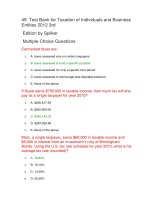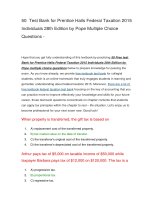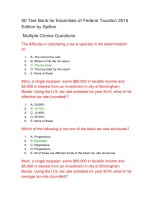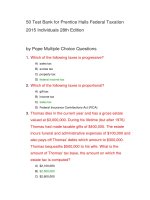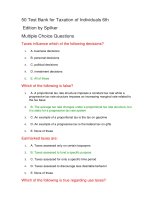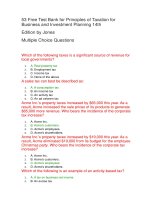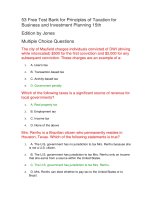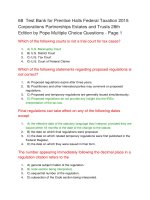68 test bank for prentice halls federal taxation 2015
Bạn đang xem bản rút gọn của tài liệu. Xem và tải ngay bản đầy đủ của tài liệu tại đây (79.37 KB, 18 trang )
68 Test Bank for Prentice Halls Federal Taxation 2015
Corporations Partnerships Estates and Trusts 28th
Edition by Pope Multiple Choice Questions - Page 1
The number appearing immediately following the decimal place in
a regulation citation refers to the
1.
A) general subject matter of the regulation.
2.
B) code section being interpreted.
3.
C) sequential number of the regulation.
4.
D) subsection of the Code section being interpreted.
Identify which of the following statements is true.
1.
A) If regulations are issued prior to the latest tax legislation dealing with a
specific Code section, the regulations are no longer effective to the extent
they conflict with the provisions in the new legislation.
2.
B) Legislative regulations are more likely to be invalidated by the courts
than are interpretative regulations.
3.
C) Regulations have more authoritative weight than tax statues.
4.
D) All of the above are false.
Title 26 of the U.S. Code includes
1.
A) income tax legislation only.
2.
B) gift tax and estate tax legislation only.
3.
C) alcohol and tobacco tax legislation only.
4.
D) all of the tax legislation mentioned above.
Which of the following documents is issued by the IRS to a
specific taxpayer?
1.
A) regulation
2.
B) revenue procedure
3.
C) letter ruling
4.
D) information release
When the House and Senate versions of a tax bill are not in
agreement, the disagreements are resolved by the
1.
A) Ways and Means Committee.
2.
B) Mediation Committee.
3.
C) Revenue Committee.
4.
D) Conference Committee.
Identify which of the following statements is true.
1.
A) Tax planning is an integral part of both closed-fact situations and openfact situations.
2.
B) The first step in conducting tax research is to clearly understand the
issues involved.
3.
C) The Statements on Standards for Tax Services recommend that only
written tax advice be provided to the client in all situations.
4.
D) All of the above are false.
Identify which of the following statements is false.
1.
A) The number "5" in the citation Reg. Sec. 1.166-5 refers to the paragraph
number.
2.
B) The Cumulative Bulletin is issued semiannually while the Internal
Revenue Bulletin is issued weekly.
3.
C) The citation Rev. Rul. 2006-5, I.R.B. 2006-1, 33, indicates that the
revenue ruling can be found on page 33 of the 1st I.R.B. for 2006.
4.
D) All of the above are false.
A Technical Advice Memorandum is usually
1.
A) an internal IRS document describing alternative legislative proposals.
2.
B) part of a Tax Court decision.
3.
C) requested by the taxpayer before entering into a taxable transaction.
4.
D) issued by the national office in response to an audit request.
Final regulations can take effect on any of the following dates
except
1.
2.
3.
4.
A) the effective date of the statutory language they interpret, provided they
are issued within 18 months of the date of the change to the statute.
B) the date on which final regulations were proposed.
C) the date on which related temporary regulations were first published in
the Federal Register.
D) the date on which they were issued in final form.
The citation "Reg. Sec. 1.199-2" refers to
1.
A) the first regulation issued in 1999.
2.
B) the second regulation issued in 1999.
3.
C) a regulation that interprets Code Section 199.
4.
D) a regulation that can be found on page 199.
Identify which of the following statements is false.
1.
A) Letter rulings are not published by the U.S. Government Printing Office.
2.
B) Technical advice memoranda are issued by the Internal Revenue
Service's National Office to provide an answer to a technical question that
arises in an audit.
3.
C) The citation Ann. 2006-12, I.R.B. 2006-51, 22 refers to an annotation of
an Internal Revenue Service release.
4.
D) Announcements are more technical than information releases.
Identify which of the following statements is false.
1.
A) When tax advisors speak of the "tax law," they usually have in mind just
the Internal Revenue Code.
2.
B) Members from both the House and the Senate are on the Conference
Committee.
3.
C) Records of committee hearings are helpful in determining Congressional
intent.
4.
D) All of the above are false.
When a taxpayer contacts a tax advisor requesting advice as to
the most advantageous way to dispose of a stock, the tax advisor
is faced with
1.
A) a restricted-fact situation.
2.
B) a closed-fact situation.
3.
C) an open-fact situation.
4.
D) a recognized-fact situation.
A tax bill introduced in the House of Representatives is then
1.
A) referred to the House Ways and Means Committee for hearings and
approval.
2.
B) referred to the entire House for hearings.
3.
C) voted upon by the entire House.
4.
D) forwarded to the Senate Finance Committee for consideration.
The citation "Rev. Rul. 2006-8, 2006-1 C.B. 541" refers to
1.
A) the eighth ruling of 2006 found on page 541 in Vol. 1 of the 2006
Cumulative Bulletin.
2.
B) the eighth ruling of 2006 found on page 541 in the 2006 volume of the
Cumulative Bulletin.
3.
C) the 541st ruling of 2006 found on page eight in Vol. 1 of the 2006
Cumulative Bulletin.
4.
D) the 1st ruling of 2006 found on page 541 in the 2006 volume of the
Cumulative Bulletin.
Which of the following courts is not a trial court for tax cases?
1.
A) U.S. Bankruptcy Court
2.
B) U.S. District Court
3.
C) U.S. Tax Court
4.
D) U.S. Court of Federal Claims
Investigation of a tax problem that involves a closed-fact situation
means that
1.
A) the client's transactions have already occurred and the tax questions
must now be resolved.
2.
B) the client's tax return has yet to be filed.
3.
C) future events may be planned and controlled.
4.
D) research is primarily concerned with applying the law to the facts as they
exist.
Which regulation deals with Code Section 165?
1.
A) Reg. Sec. 1.165-5
2.
B) Reg. Sec. 165.183-5
3.
C) Reg. Sec. 1.5-165
4.
D) Reg. Sec. 165-5
The taxpayer need not pay the disputed tax in advance when the
suit is initiated in
1.
A) U.S. Court of Federal Claims.
2.
B) U.S. Tax Court.
3.
C) U.S. District Court.
4.
D) both A and B.
The committee that is responsible for holding hearings on tax
legislation for the House of Representatives is the
1.
A) Finance Committee.
2.
B) Joint Committee on Taxation.
3.
C) Conference Committee.
4.
D) Ways and Means Committee.
The Senate equivalent of the House Ways and Means Committee
is the Senate
1.
A) Finance Committee.
2.
B) Ways and Means Committee.
3.
C) Tax Committee.
4.
D) Joint Conference Committee.
Which regulation deals with the gift tax?
1.
A) Reg. Sec. 1.165-5
2.
B) Reg. Sec. 20.2014-5
3.
C) Reg. Sec. 25.2518-5
4.
D) Reg. Sec. 301.7002-5
Which of the following best describes the weight of a revenue
ruling?
1.
A) Revenue rulings carry more weight than regulations.
2.
B) Revenue rulings carry more weight than federal court decisions.
3.
C) Regulations carry more weight than revenue rulings.
4.
D) Revenue rulings should never be used as authority since they only apply
to the taxpayer requesting the ruling.
The tax statutes with the popular name "The Internal Revenue
Code of 1986" are contained in which Title of the Code?
1.
A) 20
2.
B) 25
3.
C) 26
4.
D) 301
Regulations are
1.
A) equal in authority to legislation.
2.
B) equal in authority to legislation if statutory.
3.
C) presumed to be valid and to have almost the same weight as the IRC.
4.
D) equal in authority to legislation if interpretative.
Identify which of the following statements is true.
1.
A) Paragraph references are most commonly used when citing or referring
to the tax statutes.
2.
B) Title 26 of the United States Code and the Internal Revenue Code of
1986 are synonymous.
3.
4.
C) Before 1939, tax statutes were codified or compiled into one document.
D) The Internal Revenue Code contains chapters, which are further
subdivided into titles.
Identify which of the following statements is false.
1.
2.
A) A revenue ruling is issued by the Internal Revenue Service only in
response to a written inquiry by a taxpayer.
B) Rev. Proc. 2006-19 is a revenue procedure that was published in 2006.
3.
C) The citation Ltr. Rul. 200611075 usually indicates the ruling was made
public in the 11th week of 2006.
4.
D) A technical advice memorandum is made available as a letter ruling.
Which of the following steps, related to a tax bill, occurs first?
1.
A) signature or veto by the President of the United States
2.
B) consideration by the Senate Finance Committee
3.
C) consideration by the entire Senate
4.
D) consideration by the House Ways and Means Committee
The term "tax law" includes
1.
A) legislation.
2.
B) treasury regulations.
3.
C) judicial decisions.
4.
D) all of the above
Which of the following statements regarding proposed regulations
is not correct?
1.
A) Proposed regulations expire after three years.
2.
B) Practitioners and other interested parties may comment on proposed
regulations.
3.
C) Proposed and temporary regulations are generally issued
simultaneously.
4.
D) Proposed regulations do not provide any insight into the IRS's
interpretation of the tax law.
When Congress passes a statute with language such as, "The
Secretary shall prescribe such regulations as he may deem
necessary," the regulations ultimately issued for that statute are
1.
A) congressional regulations.
2.
B) statutory regulations.
3.
C) interpretative regulations.
4.
D) legislative regulations.
68 Free Test Bank for Prentice Halls Federal Taxation
2015 Corporations Partnerships Estates and Trusts
28th Edition by Pope Multiple Choice Questions - Page
2
Identify which of the following statements is false.
1.
A) When a court opinion discusses facts and issues on which the court
does not rule, the comments are called dicta.
2.
B) Dicta in a court opinion has no influence on other tax proceedings.
3.
4.
C) Published articles and tax services are examples of secondary sources
of authority.
D) Dicta are not authoritative.
The acquiescence policy of the IRS extends to the
1.
A) U.S. Supreme Court decisions.
2.
B) U.S. Tax Court regular decisions.
3.
C) U.S. District Court decisions.
4.
D) both B and C
Identify which of the following statements is false.
1.
A) Regular and memorandum decisions of the Tax Court are published by
the government in the Tax Court of the United States Reports.
2.
B) The citation Cristofani, 97 T.C. 74 (1991) indicates that the decision is a
regular decision of the Tax Court.
3.
C) The citation Estate of Newhouse, 94 T.C. 193 (1990), nonacq. 1991-1
C.B. 1 indicates that the IRS did not formally disagree with this 1990 Tax
Court decision until 1991.
4.
D) The Board of Tax Appeals preceded the Tax Court.
The phrase "Entered under Rule 155" indicates that
1.
A) the computation of the exact amount of the tax deficiency has been left
to the litigating parties.
2.
B) the court has not reached a decision concerning the appropriate tax
treatment of an issue.
3.
C) the parties have agreed not to appeal the decision.
4.
D) only one Tax Court judge reviewed the case.
Identify which of the following statements is true.
1.
A) The U.S. Court of Federal Claims hears cases only in Washington, D.C.
2.
B) Each state has at least one U.S. District Court.
3.
4.
C) Federal district court decisions and federal courts of appeals decisions
are not printed by the U.S. Government Printing Office.
D) All of the above are false.
Identify which of the following statements is true.
1.
A) RIA United States Tax Reporter and CCH Standard Federal Tax
Reporter are topical tax services.
2.
B) An annotated tax service is organized by broad subject areas.
3.
C) Annotations are summaries of IRS pronouncements and court opinions.
4.
D) All of the above are false.
The primary citation for a federal circuit court of appeals case
would be
1.
A) 40 AFTR 2d 78-1234.
2.
B) 44 F.Supp. 403.
3.
C) 3 F.3d 134.
4.
D) 79-2 USTC & 9693.
Internet versions of topical tax services include
1.
A) Code and Regulations.
2.
B) Revenue rulings, letter rulings, and revenue procedures.
3.
C) Court cases involving tax issues.
4.
D) All of the above.
The Tax Court departs from its general policy of ruling uniformly
for all taxpayers where
1.
A) a U.S. District Court has ruled differently on the issue in the taxpayer's
jurisdiction.
2.
B) the U.S. Court of Federal Claims has ruled differently on the issue in the
taxpayer's jurisdiction.
3.
C) the Court of Appeals in the circuit to which the Tax Court decision would
be appealed has ruled differently on the issue.
4.
D) the IRS has indicated that it will acquiesce.
You have the following citation: Joel Munro, 92 T.C. 71 (1989).
Which of the following statements is true?
1.
A) The taxpayer, Joel Munro, won the case because there is no reference
to the IRS.
2.
B) The case appears on page 71 in Volume 92 of the official Tax Court of
the United States Reports and the case was decided in 1989.
3.
C) This citation refers to a taxpayer conference between the IRS and the
taxpayer.
4.
D) The case was tried in 1989 and was appealed in 1992.
A citator is used to find
1.
2.
A) the judicial history of a case.
B) the cases that have cited a case subsequent to the issuance of the
opinion.
3.
C) whether a case has been overturned.
4.
D) all of the above.
When a court discusses issues not raised by the facts, the
comments
1.
A) are excluded from the formal court opinion.
2.
B) may be referenced by the parties in other cases having the same facts.
3.
C) are not dicta.
4.
D) will cause the court's decision to be declared invalid.
Ralph's business records were lost as a result of Hurricane
Katrina. CPA Jane prepares Ralph's return using estimates. What
do the Statements on Standards for Tax Services state about the
use of estimates?
1.
A) Estimates may not be used.
2.
B) Estimates may be used without disclosing their use to the IRS.
3.
C) Estimates may be used, but Jane should disclose their use to the IRS.
4.
D) The Statements on Standards for Tax Services do not address the use
of estimates.
Why does a researcher use a citator?
1.
A) to check on authorities issued subsequent to a court decision
2.
B) to determine whether a private letter ruling exists on the subject
3.
C) for examples of the application of a tax provision
4.
D) none of the above
Tax Court memorandum decisions
1.
A) cannot be appealed.
2.
B) are not published.
3.
C) have less precedential value than regular decisions.
4.
D) usually deal with factual variations of issues litigated previously.
When the Tax Court follows the opinion of the circuit court of
appeals to which the case is appealable, the court is following
the
1.
A) Golsen rule.
2.
B) Acquiescence rule.
3.
C) Forum shopping rule.
4.
D) Conformity rule.
A jury trial is permitted in the
1.
A) U.S. District Court.
2.
B) U.S. Tax Court.
3.
C) U.S. Court of Federal Claims.
4.
D) U.S. Tax Court when the small case procedures are used.
Identify which of the following statements is true.
1.
A) The citation, 41 TCM 1272, refers to a Tax Court regular decision
published by Commerce Clearing House.
2.
B) The Federal Supplement contains only tax cases.
3.
C) The American Federal Tax Reports contain only tax cases.
4.
D) All of the above are false.
Which of the following statements about the Statements on
Standards for Tax Services is true?
1.
A) A CPA is never allowed to use a taxpayer's estimates when preparing a
tax return.
2.
B) The CPA must tell the IRS upon becoming aware that an error has been
made on a past tax return.
3.
C) The CPA may in good faith rely on information provided by the taxpayer,
without verifying the reliability of that information if reasonable inquiries are
made where the information furnished appears to be incorrect.
4.
D) The CPA should not recommend that a taxpayer take a certain position if
there is any doubt as to whether the position would be approved by the IRS
upon audit.
Identify which of the following statements is false.
1.
A) The acquiescence policy was adopted by the U.S. Tax Court to permit
litigating parties to agree on the exact amount of the tax due.
2.
B) Letter rulings are binding only with respect to the taxpayer requesting
the ruling.
3.
C) The small cases procedure of the U.S. Tax Court allows a less formal
hearing but provides for no appeal.
4.
D) The IRS may retroactively revoke an acquiescence.
George's case was handled under the "small tax case procedure."
He does not agree with the findings of the Tax Court. He would
like to appeal the decision. Which one of the following is true?
1.
A) There is no appeal.
2.
B) He can appeal the case, but only if the amount of tax involved is greater
than $5,000.
3.
C) He would appeal first to the U.S. Court of Appeals for the Federal
Circuit.
4.
D) He would appeal first to the U.S. Court of Federal Claims.
Identify which of the following statements is false.
1.
A) Citations to the AFTR and the USTC are referred to as secondary
citations.
2.
B) A circuit court of appeals must follow the opinion of another circuit court
of appeals if the latter appeals court has previously ruled on the tax issue.
3.
C) A U.S. Supreme Court opinion in a tax matter has the same status as
Congressional tax legislation.
4.
D) Circuit Court decisions are reported in the Federal Reporter.
Statements on Standards for Tax Services are issued by
1.
A) the SEC.
2.
B) the IRS.
3.
C) the AICPA.
4.
D) the FASB.
Identify which of the following statements is false.
1.
A) The U.S. Tax Court must follow the previous decisions of the U.S.
District Court for the district in which the taxpayer lives.
2.
B) The U.S. Tax Court follows the previous decisions of the U.S. Court of
Appeals to which the tax matter is appealable.
3.
C) The opportunity for "forum shopping" occurs when different precedents
on the same point exist.
4.
D) The U. S. Tax Court may intentionally issue conflicting decisions.
According to the Statements on Standards for Tax Services, if a
CPA believes that a client's prior-year tax return contains false
information, the CPA should report this to the
1.
A) IRS.
2.
B) SEC.
3.
C) AICPA.
4.
D) None of the above. The CPA does not report the false information to any
external agencies, unless required by law.
Which tax service is usually deemed to be the most
authoritative?
1.
A) United States Tax Reporter
2.
B) Standard Federal Tax Reporter
3.
C) Federal Tax Coordinator 2d
4.
D) All are equally authoritative.
A client wants to take a tax return position with less than a 10%
probability of being upheld in court. The CPA should
1.
A) take the client's desired position, but not sign the tax return.
2.
B) inform the client that the position does not have a realistic possibility of
success.
3.
C) ask the client to sign a waiver of his right to sue the CPA in the event the
IRS disallows the position.
4.
D) take the client's desired position and sign the return as usual.
Which of the following citations is the primary citation for a U.S.
District Court case?
1.
A) 43 AFTR 2d 79-1023
2.
B) 79-1 USTC &9323
3.
C) 55 F.2d 930
4.
D) 40 F.Supp. 453
Which of the following is a true statement regarding primary
authority of tax law?
1.
A) Articles in The Journal of Taxation are viewed as primary authority.
2.
B) Primary authority includes the Code, as well as administrative and
judicial interpretations.
3.
C) The Bloomberg BNA Daily Tax Reporter is a source of primary tax
authority.
4.
D) Tax services are sources of primary tax authority.
A tax case cannot be appealed when initiated in the
1.
A) U.S. Court of Federal Claims.
2.
B) U.S. Tax Court.
3.
C) U.S. Tax Court using the small case procedures.
4.
D) none of the above
Small case procedures of the U.S. Tax Court requires that the
amount in dispute not exceed
1.
A) $5,000.
2.
B) $10,000.
3.
C) $50,000.
4.
D) $100,000.
You need to locate a recent tax case that was tried in a Federal
district court. The decision is an "unreported" decision. This
means the decision was
1.
A) not published in the Federal Supplement.
2.
B) not published in American Federal Tax Reports.
3.
C) not published in United States Tax Cases.
4.
D) settled out of court.
If the U.S. Supreme Court decides to hear an appeal a tax case, it
will grant a
1.
A) writ of appeal.
2.
B) writ of certiorari.
3.
C) writ of detainer.
4.
D) writ of habeas corpus.
Which of the following is secondary authority?
1.
A) Internal Revenue Code
2.
B) Treasury Regulations
3.
C) RIA and CCH tax services
4.
D) Revenue Ruling
Assume that you want to read a description of a particular area of
the law, along with one or more illustrations of how that law is
applied. You will not find that type of material in
1.
A) a citator.
2.
B) the Treasury Regulations.
3.
C) the Cumulative Bulletin.
4.
D) the Committee Reports.
Which of the following citations denotes a regular decision of the
Tax Court?
1.
A) 41 TCM 1272
2.
B) 35 T.C. 1083 (2003)
3.
C) 39 AFTR 2d 77-640
4.
D) all of the above
During the course of an audit, a CPA discovers an error in a prior
return. According to the Statements on Standards for Tax
Services, the CPA should
1.
A) ask the client for permission to disclose the error to the IRS.
2.
B) withdraw from the engagement.
3.
4.
C) inform the IRS of the error, regardless of whether the client grants
permission.
D) correct the error in the current year's tax return.

